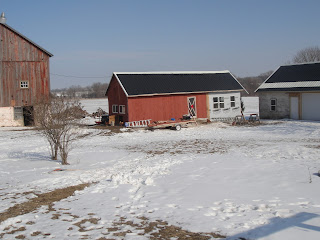 |
| A curious Ancona Pullet |
Now, the reason we had ordered only pullets is that pullets grow into hens and hens lay the eggs. Since one of our goals is profitability, eggs are a good thing. Cockerels grow into roosters--admittedly more showy than the hens, plus they make that amazing crowing sound. But can they earn their keep? You don't need a rooster in order to get eggs. You only need a rooster in order to get fertile eggs. There are many in the natural foods movement who believe that there is something better about fertile eggs. More complete. More the way it was meant to be.
 |
| An Ancona Cockerel surrounded by Black Australorp Pullets |
I haven't seen the nutritional information of one versus the other, and maybe it would be an intangible improvement anyway, but I follow where they are going with this. So, while it wasn't our intention to have roosters among our laying hens, maybe it will all work out for the best in the end. Either way, there still is nothing like the beauty of a strutting rooster with his stunning crow--and that's worth the price of admission any day.






